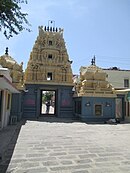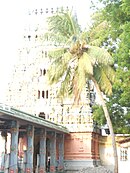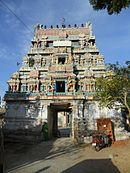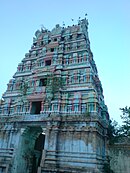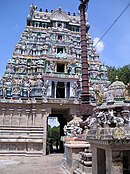Sundarar
Sundarar | |
|---|---|
 Sundarar, the poet-saint third from left | |
| Personal | |
| Born | |
| Religion | Hinduism |
| Organization | |
| Philosophy | Shaivism |
| Religious career | |
| Literary works | Tevaram |
| Honors | Nayanar |
Sundarar (Tamil: சுந்தரர், romanized: Cuntarar), also referred to as Chuntarar, Chuntaramurtti, Nampi Aruran or Tampiran Tolan, was an eighth-century poet-saint of Tamil Shaiva Siddhanta tradition of Hinduism. He is among the Tevaram trio, and one of the most prominent Nayanars, the Shaiva bhakti (devotional) poets of Tamil Nadu.[1][2]
His hymns form the seventh volume of the Tirumurai, the twelve-volume compendium of Shaiva Siddhanta. His songs are considered the most musical in Tirumurai in Tamil language.[3] His life and his hymns in the Tevaram are broadly grouped in four stages. First, his cancelled arranged marriage through the intervention of Shiva in the form of a mad petitioner and his conversion into a Shaiva devotee.[4] Second, his double marriage to temple dancers Paravai and Cankali with their stay together in Tiruvarur.[5] Third, his blindness and then return of his sight. Finally, his reflections on wealth and material goods.[4]
Names
[edit]Sundarar is referred to by many names. Sundarar (Cuntarar) means "the lovely, handsome one".[4][6] He was adopted by regional feudatory dedicated to Shiva, and that brought the name "Aruran".[4] Peers and the generations that followed him called him "Tampiran Tolan", which means "intimate companion, dedicated friend of the lord [Shiva]".[6]
Life
[edit]
The Tevaram hymns compositions of Sundarar are a source of biographical information about him, as are the hagiographic texts written about him few centuries after he died.[4] Sundarar was born in Tirunavalur in a Shaiva Brahmin family to Sadaiya Nayanar and Isaignaniyar towards the end of the 7th century.[5] He was adopted by the Narasinga Munaiaraiyar Kashatriya family, a Pallava feudatory (Thirumunaipadi-Nadu, an adoption that gave him a luxurious childhood.[4]
Sundarar is unique among the Nayanars in that both of his birth parents are also recognized as Nayanars (poet-saints of Tamil Shaivism). They were temple priests and accepted the adoption request of the local feudatory. Once he came of age, his adopted family arranged his marriage. However, as the wedding party approached the local Shiva temple, states the traditional legend, an old man mysteriously appears and produces a palm leaf document. The document stated that Sundarar was bonded to serve him, the old man, his master. A court of elders then reviews the document and finds it authentic, demands Sundarar to serve the petitioner, who then mysteriously vanishes in the Shiva shrine. Sundarar views this as a command to cancel the wedding and serve Shiva in the Tiruvarur temple.[7][8]
Sundarar began his first poem (Tevaram VII.1.1) by addressing Shiva as Pittaa pirai chudi.. meaning O mad man..:[8][9][10]
O madman with the moon-crowned hair,
God of grace,
O Lord, how can I forget you?
You dwell forever in my heart,
In Arutturai, shrine of grace,
in Venneynallur on Pennai's southern bank,
you took me for your own–
how can I deny you now?
– Translated by Indira Peterson[11]

In the next stage of his life, Sundarar moved around Tamil Nadu, visiting Shiva Temples of Tamil Nadu. In Tiruvarur, he fell in love with a temple dancer named Paravayar, and married her.[3] After few years of married life, Sundarar visits the Siva temple in Thiruvottriyur, a sea-side suburb of Madras. There he meets and is enamoured by a peasant Vellala girl Cankali.[5] With the help of Shiva, this leads to Sundarar's second marriage, but only after his wedding vows include the promise of never leaving Cankali and Thiruvottriyur.[7] After marrying his second wife, Sundarar misses his first wife Paravai. He does not keep his word, and leaves for Tiruvarur. The broken vow causes him to go blind before he reaches Tiruvarur. His suffering thereafter are part of several Tevaram hymns.[12] As a blind man, he visits many Shiva shrines and sings there. Slowly in stages, he becomes closer to Shiva and recovers his sight.[13]

Another legends states that Cheraman Perumal Nayanar – the king of the region now known as Kerala, heard of him and came to Tiruvarur. Both embarked on a pilgrimage together. He died during this pilgrimage.[14] Zvelebil estimates that Sundarar died about 730 CE.[5]
In his later hymns, he presents his spiritual discussions with Shiva on how to achieve both spiritual succor and material wealth in life. He seeks the latter to provide for his family and to pay for the charitable temple kitchen that fed hundreds of Shaiva pilgrims. Shiva becomes his patron king, grants him grain, gold and a flashing sword. This is embedded symbolism to inspire regional kings and wealthy patrons to support the spiritual and charitable works at Shiva temples.[15]
Compilation
[edit]| The twelve volumes of Tamil Śaiva hymns of the sixty-three Nayanars | ||
| Parts | Name | Author |
| 1,2,3 | Thirukadaikkappu | Sambandar |
| 4,5,6 | Thevaram | Thirunavukkarasar |
| 7 | Thirupaatu | Sundarar |
| 8 | Thiruvasakam & Thirukkovaiyar |
Manickavasagar |
| 9 | Thiruvisaippa & Tiruppallaandu |
Various |
| 10 | Thirumandhiram | Thirumular |
| 11 | Various | |
| 12 | Periya Puranam | Sekkizhar |
| Paadal Petra Sthalam | ||
| Paadal Petra Sthalam | ||
| Rajaraja I | ||
| Nambiyandar Nambi | ||
Like the Tevaram trio, Sundarar's hymns were passed on through the oral tradition for a few centuries. Sometime around 1000 CE, Raja Raja Chola I (985-1013 CE) heard short excerpts of Shiva hymns in his court. He then embarked on a mission to recover the hymns.[16] He sought the help of Nambiyandar Nambi, who was a priest in a Ganesha temple.[16][17]
Nambi, states the tradition, prayed before Ganesha for success in finding the manuscripts. Nambi found the scripts in the form of cadijam leaves half eaten by white ants in a chamber inside the second precinct in Thillai Nataraja Temple, Chidambaram. Tradition attributes this discovery to Shiva's intervention.[16][17] The temple priests of Chidambaram refused to let Nampi and king to take the manuscript from the temple. They said that their temple rules demand that this can only happen if the Tevaram trio come to the temple. The king then had stone idols of the three poet-saints built and brought them to the temple in royal procession. Once the Tevaram trio images were consecrated, the temple priests allowed Nambi to take the manuscript for his studies and compilation.[16][18] This, states Vasu, began the tradition of placing Nayanar statues in large Tamil Shiva temples.[18]
Nambi arranged the hymns of three saint poets Sambandar, Appar and Sundarar as the first seven books.[19] Sundarar's composition is compiled in the seventh volume of the Tevaram. It consists of 100 hymns, consisting of 1026 stanzas.[5]
Sundarar compositions have a signature last stanza, where he links his hymns to Shiva, the Vedas or a temple location, and the benefits of reciting or listening to that hymns.[20] For example, at the end of hymn VII.54:[21]
Those who know these ten verses
that Uran, the Rude Devotee,
chanter of the four Vedas and sacred texts,
praised by the world,
very pious young man,
has sung on the dear one,
who dwells at the shrine in wave-washed Orriyur,
will surely reach the highest state.
– Translated by Indira Peterson[21]
Legacy
[edit]Sundarar shared the same respect as Sambandar and Appar for the Vedas. Together, they connected the Vedic ritual to the temple Agamic puja that is ever since followed in Shiva temples.[22][23] According to John Cort – a scholar of Jainism and Hinduism studies, the Agamic temple rituals perpetuate the Vedic practices. The efforts of the Tevaram trio and other Nayanars helped transform this "as the central element of the Saiva Siddhanta philosophical and theological system, and thus of Tamil Saiva soteriology", states Cort, by emphasizing the instrumentality and efficacy of the temple and its rituals. According to the Nayanars, the Vedic and the Agamic overlap, are alternate roads to the same spiritual end, both evoke a transformation in the devotee, with the difference that temple-based Saiva puja alone is emphasized.[23]
The Shiva temple-centered community tradition has thrived among Tamils since the times of Sambandar, Appar and Sundarar. Odhuvars, Sthanikars, or Kattalaiyars offer musical programmes in Shiva temples of Tamil Nadu by singing Tevaram after the daily rituals.[24] These are usually carried out as chorus programme soon after the divine offering. The singing of Tevaram was followed by musicals from the music pillars in such temples like Madurai Meenakshi Amman Temple, Nellaiappar Temple and Suchindram.[25] The singers of these hymns were referred as Tirupadiyam Vinnapam seyvar or Pidarar, from the inscriptions of Nandivarman III in the Tiruvallam Bilavaneswara temple records. Rajaraja deputed 48 pidarars and made liberal provisions for their maintenance and successors.[18]
Translations
[edit]Francis Kingsbury and GE Phillips selected and translated 15 out of 100 of Sundarar's hymns into English in 1921. These were published with small collection of Sambandar and Appar hymns in a book titled Hymns of the Tamil Śaivite Saints, released by the Oxford University Press. They stated that these were some of the hymns from Devaram (Tevaram) that they could hear being chanted in South Indian Shiva temples of their times.[26]
More recent English translations of many more select hymns by Sundarar have been published by Indira Peterson,[27] and David Shulman.[28]
Temple traditions
[edit]Sundarar's pilgrimage to Shiva temples and his efforts helped expand the Shaiva sacred geography in Tamil Nadu. Like Sambandar and Appar, Sundarar's hymns have been helpful in identifying and dating many of the old Shiva temples found in Tamil Nadu. These have been helpful to art historians, and for architectural, archaeological and religious studies.[29]
List of temples associated with Sundarar
| ||||||||||||||||||||||||||||||||||||||||||||||||||||||||||||||||||||||||||||||||||||||||||||||||||||||||||||||||||||||||||||||||||||||||||||||||||||||||||||||||||||||||||||||||||||||||||||||||||||||||||||||||||||||||||||||||||||||||||||||||||||||||||||||||||||||||||||||||||||||||||||||||||||||||||||||||||||||||||||||||||||||||||||||||||||||||||||||||||||||||||||||||||||||||||||||||||||||||||||||||||||||||||||||||||||||||||||||||||||
|---|---|---|---|---|---|---|---|---|---|---|---|---|---|---|---|---|---|---|---|---|---|---|---|---|---|---|---|---|---|---|---|---|---|---|---|---|---|---|---|---|---|---|---|---|---|---|---|---|---|---|---|---|---|---|---|---|---|---|---|---|---|---|---|---|---|---|---|---|---|---|---|---|---|---|---|---|---|---|---|---|---|---|---|---|---|---|---|---|---|---|---|---|---|---|---|---|---|---|---|---|---|---|---|---|---|---|---|---|---|---|---|---|---|---|---|---|---|---|---|---|---|---|---|---|---|---|---|---|---|---|---|---|---|---|---|---|---|---|---|---|---|---|---|---|---|---|---|---|---|---|---|---|---|---|---|---|---|---|---|---|---|---|---|---|---|---|---|---|---|---|---|---|---|---|---|---|---|---|---|---|---|---|---|---|---|---|---|---|---|---|---|---|---|---|---|---|---|---|---|---|---|---|---|---|---|---|---|---|---|---|---|---|---|---|---|---|---|---|---|---|---|---|---|---|---|---|---|---|---|---|---|---|---|---|---|---|---|---|---|---|---|---|---|---|---|---|---|---|---|---|---|---|---|---|---|---|---|---|---|---|---|---|---|---|---|---|---|---|---|---|---|---|---|---|---|---|---|---|---|---|---|---|---|---|---|---|---|---|---|---|---|---|---|---|---|---|---|---|---|---|---|---|---|---|---|---|---|---|---|---|---|---|---|---|---|---|---|---|---|---|---|---|---|---|---|---|---|---|---|---|---|---|---|---|---|---|---|---|---|---|---|---|---|---|---|---|---|---|---|---|---|---|---|---|---|---|---|---|---|---|---|---|---|---|---|---|---|---|---|---|---|---|---|---|---|---|---|---|---|---|---|---|---|---|---|---|---|---|---|---|---|---|---|---|---|---|---|---|---|---|---|---|---|---|---|---|---|---|---|---|---|---|---|---|---|---|---|---|---|---|---|---|---|---|---|---|---|---|---|---|---|---|---|---|---|---|
|
Notes
[edit]- ^ Peterson 1989, p. 21.
- ^ Wendy Doniger O'Flaherty (1990). Textual Sources for the Study of Hinduism. University of Chicago Press. p. 170. ISBN 978-0-226-61847-0.
- ^ a b Appar : a sketch of his life and teachings. Natesan & Co. 1918. p. 8. JSTOR saoa.crl.25894664.
- ^ a b c d e f Peterson 1989, pp. 302–303.
- ^ a b c d e Zvelebil 1974, pp. 95–96.
- ^ a b Zvelebil, Kamil V.; Shulman, David Dean (1993). "Songs of the Harsh Devotee: The Tēvāram of Chuntaramūrttināyaṉār". Journal of the American Oriental Society. 113 (2). JSTOR: 327. doi:10.2307/603072. ISSN 0003-0279. JSTOR 603072.
- ^ a b Peterson 1989, pp. 303–304.
- ^ a b Sisir Kumar Das. A History of Indian Literature, 500-1399: From Courtly to the Popular. Sahitya Akademi, 2005 - India - 302 pages. p. 33.
- ^ Don Handelman; David Dean Shulman. Śiva in the Forest of Pines: An Essay on Sorcery and Self-knowledge. Oxford University Press India, 2004 - Religion - 246 pages. p. 167.
- ^ Meenakshi Khanna. Cultural History of Medieval India. Berghahn Books, 2007 - History - 248 pages. p. 59.
- ^ Peterson 1989, p. 303.
- ^ Peterson 1989, pp. 305–307.
- ^ Peterson 1989, pp. 305–312 with footnotes.
- ^ Dallapiccola, A. L. (2002). "Sundarar or sundaramurti nayanmar". Dictionary of Hindu lore and legend. London, UK: Thames & Hudson: Thames & Hudson. Retrieved 3 December 2017.
- ^ Peterson 1989, pp. 313–319.
- ^ a b c d Culter 1987, p. 50
- ^ a b Cort 1998, p. 178
- ^ a b c Vasudevan 2003, pp. 109-110
- ^ Zvelebil 1974, pp. 90–96.
- ^ Peterson 1989, pp. 302–322.
- ^ a b Peterson 1989, pp. 307–308.
- ^ Nagaswamy 1989, pp. Chapter 6.
- ^ a b Cort 1998, p. 176
- ^ Ghose 1996, p. 239
- ^ Bhargava 2006, p. 467
- ^ Kingsbury, F (1921). Hymns of the Tamil Saivite Saints (1921) (PDF). Oxford University Press. pp. 35–68. Retrieved 8 July 2014.
- ^ Peterson 1989.
- ^ Chuntarar; David Shulman (Translator) (1990). Songs of the Harsh Devotee: The Tēvāram of Chuntaramūrttināyan̲ār. University of Pennsylvania. ISBN 978-0-936115-07-8.
{{cite book}}:|author2=has generic name (help) - ^ David Smith 2003, pp. 65, 163–167, 209–234.
References
[edit]- Ayyar, P. V. Jagadisa (1993). South Indian shrines: illustrated. Asian Educational Services. ISBN 81-206-0151-3.
- Bhargava, Gopal K.; Shankarlal C. Bhatt (2006). Land and people of Indian states and union territories. 25. Tamil Nadu. Delhi: Kalpaz Publications. ISBN 81-7835-381-4.
- Callewaert, Winand M.; Rupert Snell (1994). According to tradition: hagiographical writing in India. Otto Harrasowitz. ISBN 978-3-447-03524-8.
- Coward, Harold G. (1987). Modern Indian responses to religious pluralism. New York: State University of New York. p. 151. ISBN 0-88706-571-6.
- Cort, John E. (1998). Open boundaries: Jain communities and culture in Indian history. Albany: State University of New York Press. ISBN 0-7914-3786-8.
- Cutler, Norman (1987). Songs of experience: the poetics of Tamil devotion. USA: Library of Congress Cataloging-in-Publication-Data. ISBN 0-253-35334-3.
- Eliot, Charles (September 2007). Hinduism and Buddhism, Vol II. (of 3). Middlesex: Eco Library. ISBN 978-1-4068-6296-6.
- Harman, William P. (1992), The sacred marriage of a Hindu goddess, Delhi: Indiana University Press, ISBN 978-1-59884-655-3.
- Khanna, Meenakshi (2007). Cultural History of Medieval India. Delhi: Social Science Press. ISBN 978-81-87358-30-5.
- Prentiss, Karen Pechilis; Karen Pechilis (1999), The embodiment of bhakti, New York: Oxford University Press, ISBN 0-19-512813-3.
- Nagaswamy, R. (1989). Siva Bhakti. New Delhi: South Asia Books. ISBN 978-8170130284. OCLC 20573439.
- Vasudevan, Geetha (2003), The royal temple of Rajaraja: an instrument of imperial Cola power, New Delhi: Abhinav Publications, ISBN 81-7017-383-3
- Zvelebil, Kamil (1974). A History of Indian literature Vol.10 (Tamil Literature). Otto Harrasowitz. ISBN 3-447-01582-9.
- Dorai Rangaswamy, M.A. (1958). The Religion And Philosophy Of Tevaram, Book I (Volumes 1 and 2). University of Madras.
- Dorai Rangaswamy, M.A. (1959). The Religion And Philosophy Of Tevaram, Book II (Volumes 3 and 4). University of Madras.
- R. Champakalakshmi (2007). Meenakshi Khanna (ed.). Cultural History of Medieval India. Delhi: Social Science Press. ISBN 978-81-87358-30-5.
- David Smith (2003). The Dance of Siva: Religion, Art and Poetry in South India. Cambridge University Press. ISBN 978-0-521-52865-8.
- Spencer, George W. (1970). "The Sacred Geography of the Tamil Shaivite Hymns". Numen. 17 (Fasc. 3): 232–244. doi:10.1163/156852770X00063. JSTOR 3269705.
- Peterson, Indira Viswanathan (1989). Poems to Siva: The Hymns of the Tamil Saints. Princeton: Princeton University Press. ISBN 9780691067674. JSTOR j.ctt7zvqbj. OCLC 884013180.
- B.G.L. Swamy (1975). "The Date of the Tevaram Trio: An Analysis and Reappraisal". Bulletin of the Institute of Traditional Cultures. University of Madras: 119–179.
- G. Vanmikanathan (1985). N. Mahalingam (ed.). Periya Puranam: A Tamil Classic on the Great Saiva Saints of South India by Sekkizhar. ISBN 978-81-7823-148-8.
Further reading
[edit]- Swamigal, Sundaramurthi. "tEvAram of chuntaramUrti cuvAmikaL tirumuRai 7, part 1 Poems (1-517)" (PDF). projectmadurai.org. Retrieved 13 December 2011.
- Swamigal, Sundaramurthi. "tEvAram of chuntaramUrti cuvAmikaL tirumuRai 7, part 2 Poems (518-1026)" (PDF). projectmadurai.org. Retrieved 13 December 2011.
- Dictionary of Hindu Lore and Legend (ISBN 0-500-51088-1) by Anna Dallapiccola
- Songs of the harsh devotee by David Dean Shulman
- The religion and philosophy of thevaram by M.A. Dorai Swamy
- Development of Religion in South India by K. A. Nilakanta Sastri
- Arupathu Moovar Kadhaigal by Durgadas S. K. Swamy (Prema Pirasuram publishers)
- Origin and early history of Śaivism in South India By Sadananda (Swami.)
- Ten saints of India By T. M. P. Mahadevan
- A short introduction to Saivism By Subodh Kapoor
- Songs of Sundararmoorthy Swamigal
- Life of Sundaramoorthy Swamigal
External links
[edit]- Shaiva Saint Sundarar, Norton Simon Museum
- Saint Sundarar with wife Paravai, Smithsonian












